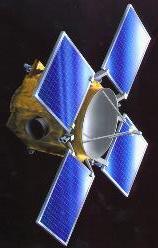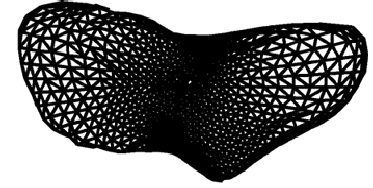
Why it's difficults to get a complete picture of Eros:
- Unlike planets, which are almost spherical, asteroids can be shaped like, well, almost anything. Eros' shape has been described like that of: a banana; a potato; a potato with a bite taken out of it; a boomerang; a drumstick; a peanut with a tumor; and a sock. This is what it looks like from the north pole:

- Eros' axis of rotation is in the same plane as its orbit around the sun (compare that to the earth, whose axis of rotation is about 70 degrees out of the plane of its orbit around the sun). Eros rotates about the sun once every 1.7 years. This means that the northern hemisphere experiences permanent daylight (and the southern hemisphere permanent night) for about 5 months. For the next 5 months, Eros has day and night every 5.27 hours (the period of its rotation about its axis). Then the southern hemisphere gets 5 months of daylight, and then back to alternating between day and night for another 5 months. (The picture ought to make this clearer)
The spacecraft enters orbit while the northern hemisphere of Eros is in permanent daylight.
- Our simulations could be way off if Eros has a significantly different shape, mass, density, or moment of inertia than we otherwise thought. For a descritpion of where the data we are using came from, see "Estimating the Mass of Asteroid 433 Eros During the NEAR spacecraft flyby," Yeomens et.al., in the July 23 1999 issue of Science
- The power for all of NEAR's data-gathering instruments comes from its solar panels. NEAR cannot stay out of sunlight for long periods of time without shutting down. The spacecraft's orbit cannot take it out of the sunlight for any significant period of time. Therefore, the spacecraft needs to orbit around Eros' terminator (the division between night and day).
- The data gathered by the MSI camera can tell us about two different things: the composition of the asteroid, and the topology of the asteroid. Information about the composition of the asteroid comes from pictures that are taken at a relatively low emission angle (the emission angle is the angle between a normal to the surface and the light ray reflected from the surface which is seen by the spacecraft). Information about the topology comes from pictures that are taken at a relatively high emission angle. Complete coverage means getting both sets of data for the whole asteroid.
- The spacecraft needs to spend 8 hours every day downlinking -- sending data back to the earth. When it does this, the whole spacecraft rotates and the cameras are no longer pointing at Eros.
- The MSI is not the only instrument on NEAR; there are other instruments, like the NLR, which need to take data during part of the orbit. While they are taking data, we may or may not be able to take data with the MSI.
- Depending on when the NLR time and downlink time are scheduled, it's possible that there could be certain latitudes of the asteroid which we never get pictures of. We won't know until the end of August when the dowlink time and NLR time will be. Right now, we're assuming worst-case scenario; if you want to, you can look at a timeline which shows the schedule that we're using now.
- All the pictures taken in the 16 hours between downlink times must be stored in the computer, and all the data stored in the computer must be sent back to earth during the 8 hours of downlink. During downlink, we can send back approximately 570 Mb of data, which corresponds to about 600 MSI (Multi-Spectral Imager) pictures per day.
/NEAR/SEQ/parameters.html
